You're using an outdated browser. Please upgrade to a modern browser for the best experience.
Please note this is a comparison between Version 1 by Liu Wei and Version 3 by Dean Liu.
Linear infrastructures, such as railways, tunnels, and pipelines, play essential roles in economic and social development worldwide. Distributed acoustic sensing (DAS) is an emerging sensing technology that has rapidly developed in recent years. Due to its unique advantages in long-distance, high-density, and real-time monitoring, DAS arrays have shown broad application prospects in many fields, such as oil and gas exploration, seismic observation, and subsurface imaging. In the field of linear infrastructure monitoring, DAS has gradually attracted the attention of researchers and practitioners.
- distributed acoustic sensing (DAS)
- linear infrastructure
- field monitoring
1. Introduction
Linear infrastructures, such as railways, highways, pipelines, tunnels, embankments and power transmission lines, are a general type of civil infrastructures with long spans. They have the characteristics of long lengths, wide distribution ranges, and long service lives and they are widely distributed in complex and changeable natural environments. They form the backbone of society and play important roles in economic and social development. However, due to the influence of geohazards, earthquakes, corrosion, aging, human activities, and other multiple factors, linear infrastructures face the potential risk of structural deterioration and damage during their service lives [1]. In the past few decades, accidental extraordinary events among linear infrastructures in long-term operations have aroused widespread concern. For instance, water, oil, and gas pipelines have sometimes been damaged by nearby earthworks, landslides, and third-party invasions [2][3][2,3]; some dramatic traffic disasters have been caused by rail rust and land subsidence; in some countries, border protection walls and barriers have been damaged by illegal immigration. Therefore, to ensure the safe and reliable operation of linear infrastructures and prevent potential threats in the long run, robust and efficient monitoring systems are required.
The establishment of monitoring and early warning systems for linear infrastructures is key to ensuring their health conditions and reducing the occurrence of disasters. At present, linear engineering monitoring mainly relies on manual inspections and field monitoring. The former is relatively expensive and intermittent [4]. For the latter, the commonly used methods are categorized into two types, i.e., remote sensing and contact monitoring methods. Interferometric synthetic aperture radar (InSAR) and global navigation satellite systems (GNSS) are two popular remote sensing technologies with millimeter-level accuracy for displacement monitoring [5][6][5,6]. In recent years, unstaffed aerial vehicle (UAV) photogrammetry and terrestrial laser scanning (TLS) have provided effective solutions for ground surface deformation monitoring with higher accuracy [7]. Although these technologies can obtain large-scale deformation data, monitoring is periodic and only applicable to surface deformations. For subsurface monitoring, a series of geotechnical instruments have been developed, e.g., extensometers, inclinometers, tiltmeters, and piezometers [8]. These can be installed in boreholes of different depths or directly fixed on linear infrastructures to carry out performance monitoring. In this way, the automatic and continuous monitoring of key physical parameters can be enabled, as well as early warnings of abnormal states or accidents. However, most of the instruments are based on single-point measurements and struggle to realize long-distance monitoring. For the above reasons, powerful and robust monitoring technologies for linear infrastructures are urgently needed to provide accurate and comprehensive measurements in real time.
Distributed acoustic sensing (DAS) is a new type of fiber-optic sensing technology that has rapidly developed in recent years. It not only has the advantages of ordinary fiber-optic sensing technologies (e.g., anti-electromagnetic interference, corrosion resistance, slenderness, and flexibility) but it can also measure dynamic strains (e.g., vibrations and sound waves) along fiber paths in a long-distance, fully distributed, and real-time manner [9]. In the past decade, there have been many successful applications of DAS in the field of geophysical detection, such as vertical seismic profile (VSP) acquisition [10][11][12][10,11,12], hydraulic fracturing monitoring [13][14][15][13,14,15], earthquake observation [16][17][18][16,17,18], and structural detection and imaging [19][20][21][19,20,21]. In the fields of acoustics [22][23][22,23] and biology [24][25][24,25], DAS has also shown its powerfulness. With the rapid development of demodulation techniques, the applications of DAS have gradually extended from land to ocean [26][27][28][26,27,28], glaciers [29][30][29,30], and volcanoes [31][32][31,32].
For linear infrastructures, DAS provides a novel monitoring solution. The large-scale, long-distance, and real-time sensing capabilities of DAS mean that it has unreplaceable advantages for field monitoring. In addition, fiber-optic cables have strong environmental adaptability and can easily collect huge monitoring data along their fiber lengths. Therefore, DAS can be tailored for monitoring linear infrastructures in complex and harsh environments. In recent years, researchers and practitioners worldwide have carried out a large number of field investigations on linear infrastructures using DAS, such as pipeline leakage monitoring [33][34][33,34] and rail track health monitoring [35][36][35,36]. Figure 1 briefly shows some current and potential application scenarios of DAS for monitoring linear infrastructures and related geohazards.
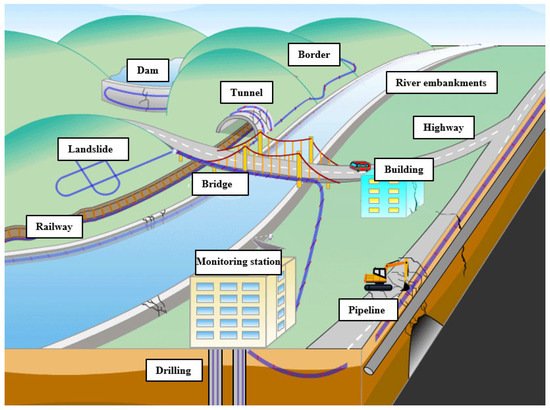
Figure 1. Current and potential application scenarios of DAS for monitoring linear infrastructures and geohazards. Adapted with permission from Ref. [37]. 2017, MDPI publisher.
Current and potential application scenarios of DAS for monitoring linear infrastructures and geohazards. Adapted with permission from Ref. [37]. 2017, MDPI publisher.
2. Railway Safety Monitoring
2.1. Train Positioning and Speed Monitoring
Railway management departments worldwide need to accurately monitor train positioning and speed information to ensure the safety of trains. In train positioning and speed monitoring, track circuit technology is widely used [38][47]. However, in some extreme weather conditions, such as super-strong lightning, track circuit technology may not work properly. Other sensing technologies also have application limitations. For instance, global positioning systems (GPS) have weak sensing capabilities in closed environments, such as tunnels, and cannot obtain accurate train motion information.
The development of DAS has provided a new solution for train positioning and speed monitoring. The advantages of DAS (strong anti-electromagnetic interference, high temporal resolution, etc.) can make up for the shortcomings of existing monitoring technologies. DAS systems are also convenient to use to perform field monitoring by just connecting a sensing cable to an interrogation unit, as shown in Figure 24. Since trains generate strong vibration signals during the running process, sensing cables close to trains vibrate strongly, while sensing cables far away from the trains are undisturbed and only record background noise. Therefore, the position and running speed of trains can be easily determined by analyzing the recorded data from the cables at each position.
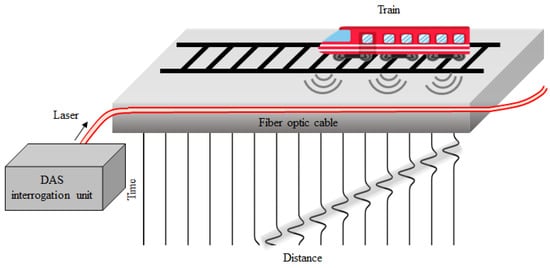
Figure 24.
Schematic diagram of train positioning and speed monitoring based on DAS.
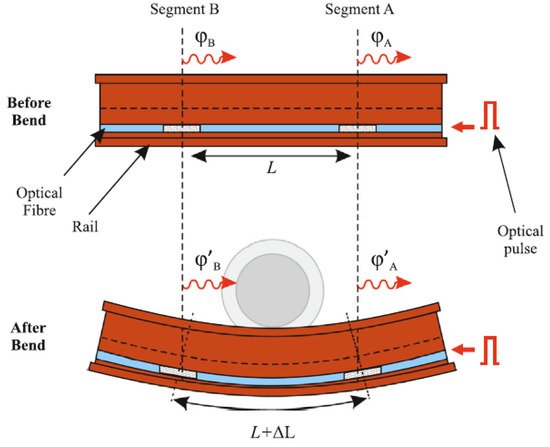
As early as 2014, Peng et al. conducted a field study [39][48]. They laid a 10.2 km sensing cable along a track to record vibration signals as trains were moving. From the DAS data, the position and running speed of trains at various time points could be clearly seen, demonstrating the feasibility of DAS for train positioning and speed monitoring. Since then, an increasing number of field trials have been carried out [40][41][42][49,50,51]. However, utilizing DAS for train positioning and speed monitoring also faces some challenges; for instance, how to bury sensing cables near tracks without affecting railway transportation and how to quickly extract effective information from continuous monitoring data. To process sensing data accurately and quickly, a variety of intelligent algorithms have been developed [36][42][43][36,51,52]. He et al. proposed an improved Canny algorithm for precise train positioning and the feasibility of this algorithm has been verified through field experiments [43][52]. The results showed that the positioning error is less than 10 m. The same authors also proposed a cubical smoothing algorithm with a five-point approximation to denoise vibration signals and shorten the calculation time. Wiesmeyr et al. proposed a real-time train tracking algorithm that runs on the basis of 1 s signals without delay [36]. This algorithm combines machine learning techniques, such as principal component analysis (PCA) and support vector machines (SVMs), with image processing methods, such as edge monitoring and Kalman filtering. The field implementation results showed that this real-time tracking algorithm achieves 98% accuracy. For the burial of fiber-optic cables, Vidovic et al. proposed the use of existing fiber-optic cables near tracks for monitoring, which could greatly reduce monitoring costs [44][53]. However, the key point is to accurately locate the buried positions, especially those of the winding parts and redundant parts of cables. In addition, “tap tests” must be performed to obtain the corresponding relationships between the spatial positions of fiber-optic cables and channel numbers, which take considerable time to process. Vidovic et al. suggested the use of train platforms, bridges, and other positions as reference points in engineering practice [44][53].
3. Rail Track Health Monitoring
Ever-increasing railway traffic not only drives social and economic development but also aggravates the wear and tear of tracks. At present, rail track health monitoring mostly relies on manual inspections and conventional deformation monitoring devices, such as track inspection vehicles, accelerometers, and strain gauges near the tracks. However, both manual monitoring and track inspection vehicle monitoring have certain monitoring periods and it is impossible to evaluate the health status of tracks in real time. Some sensors, such as accelerometers and strain gauges, cannot be deployed around tracks in a large-scale and intensive manner for monitoring due to their high prices.
Some researchers have proposed the use of distributed fiber-optic sensing (DFOS) technologies to evaluate the health status of tracks, such as Brillouin optical time domain analysis (BOTDA) [45][54] and optical frequency domain reflectometry (OFDR) [46][55]. These sensing technologies have a high sampling density and can obtain huge amounts of information on the health status of tracks. However, BOTDA cannot realize real-time sensing and OFDR has limitations in detection distance. On the contrary, DAS has the potential to greatly extend detection distances with super-high sensitivity, which could provide an ideal solution to track health monitoring.
In recent years, many successful trials have been introduced [40][41][42][49,50,51]. Milne et al. pointed out that DAS can be used to measure track deflections and sleeper end loads [35]. They pasted sensing cables under rails and performed back calculations using the track strain data that were recorded by the sensing cables, as shown in Figure 35. To verify the feasibility of this measurement method, the results from the DAS, strain gauges, and digital image correlation (DIC) were compared, which showed good consistency. Guo et al. developed an intelligent detection method for track slab deformation based on a random forest model and carried out field experiments to verify it [47][56]. The test results showed that this intelligent algorithm can effectively identify deformations in track slabs and the recognition rate reaches 96.09%. Wang et al. also pointed out that DAS has the potential to detect track health status [48][57]. They used deep convolutional networks to detect the health status of tracks and conducted field experiments to verify them. The test results showed that the accuracy of the recognition method reaches 98.04%. The above experimental results demonstrate the application potential of DAS in the field of track health monitoring. However, these applications also face some challenges. On the one hand, some trace vibration characteristics that could identify issues may be submerged within strong external noise. On the other hand, analyzing the health status of tracks based on artificial intelligence technology requires a large amount of labeled data, which is difficult to obtain [48][57]. In the future, researchers should work closely with railway departments to develop intelligent algorithms with stronger denoising and higher recognition capabilities. In addition, researchers could also combine DAS with other technologies to jointly monitor the health of railway tracks in order to compensate for the lower detection ability of a single detection technology, thereby breaking through the abovementioned developmental bottlenecks.

Figure 35. Schematic diagram of fiber-optic cable layout and sensing. Reprinted with permission from Ref. [35]. 2020, Elsevier. In the figure, φ represents the phase information, L is the length, and ΔL is the change in length.
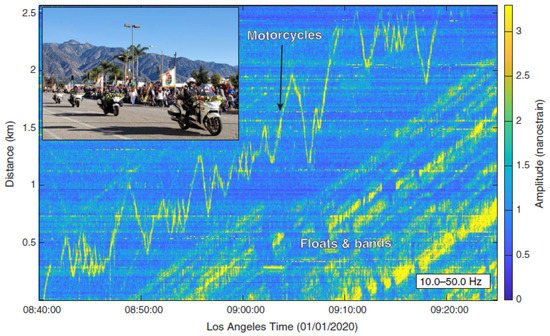
4. Roadbed Velocity Structure Imaging
When trains are running at high speeds, some of their energy is transmitted in the form of seismic waves due to the extrusion, friction, and collision between the trains and the tracks. The seismic waves excited by trains are good active source seismic wave fields, which contain the structural and dynamic characteristics of the tracks and roadbeds [49][50][51][58,59,60]. By analyzing changes in seismic waves, structural defects in roadbeds can be monitored and disaster warnings for high-speed railways can be realized.
Restricted by multiple factors, such as cost, power, and burial location, it is difficult for traditional seismic sensing devices (nodal seismographs, narrowband geophones, broadband seismographs, etc.) to be deployed on a large scale and for long periods of time along railways. DAS breaks through the above limitations nicely. The detection units on fiber-optic cables do not need to be powered separately, only the interrogation units need to be supplied with power. In addition, there is a large number of existing communication fiber-optic cables along railways. As long as the cables are connected to interrogation units, rwesearchers c can form long-distance, real-time and dense seismic sensing networks. Recently, researchers have monitored and analyzed seismic signals generated by moving trains with the aid of DAS [52][53][61,62]. Shao et al. extracted surface wave signals from DAS records through seismic interference technology and then used the multi-analysis surface wave (MASW) method to carry out inversion work. Finally, they successfully obtained the shallow shear wave velocity structure under a roadbed, which fully demonstrates the feasibility of DAS in roadbed velocity structure imaging [52][61].
However, research in this field is still in its infancy. On the one hand, trains are moving sources and the seismic waves they excite are very complex. On the other hand, DAS is only sensitive to seismic waves that propagate in specific directions due to its direction sensitivity. The above factors limit the further development of DAS in the field. It is believed that with the continuous deepening of research, these bottlenecks can be broken through and DAS can be integrated with high-speed rail seismology in the future.
5. Highway Traffic Monitoring
Highway traffic is an essential part of people’s lives. To monitor highway traffic, a variety of fixed (radar guns, road sensors, cameras, etc.) and mobile (vehicle GPS, mobile phones, etc.) monitoring technologies have been developed in recent years. The former can provide high-resolution monitoring data but their installation and maintenance costs are high and their space coverage is relatively low. The latter have high space coverage but their data collection frequency is low, so they cannot perform real-time monitoring and may also involve personal privacy problems [54][63]. Therefore, new traffic monitoring systems are urgently required.
DAS systems could provide an alternative for highway traffic monitoring. Because fiber-optic cables are buried under roads, this detection method has strong concealment qualities and the cables embedded underground can avoid physical damage during long-term monitoring. In recent years, there have been several good examples of applying DAS to highway traffic monitoring [55][56][57][64,65,66]. Wang et al. monitored the Pasadena Rose Parade using a communication cable under the road [58][67]. By analyzing the vibration information collected by the cable, they successfully identified traffic characteristic signals, such as pedestrians, motorcycles, and floats (Figure 46). They also proposed a method to measure road traffic flow and speed and analyzed urban road traffic conditions before and after the outbreak of COVID-19 [54][63]. The results are shown in Figure 57. It can be clearly seen that the overall traffic flow in the city decreased after the outbreak of COVID-19, while the speed increased. They also compared the monitoring results from DAS to those from other monitoring technologies and found that they had good consistency, which successfully proves the feasibility of DAS in highway traffic monitoring. Catalano et al. proposed the application of the Hough transform to vehicle counting and demonstrated an algorithm for the automatic detection and counting of vehicles [59][68]. Field tests showed that the accuracy rate of the algorithm reaches 73%.

Figure 46. Seismic records (10.0–50.0 Hz) showing the vibrations caused by motorcycles, floats, and bands. Reprinted with permission from Ref. [58][67]. 2020, Seismological Society of America.
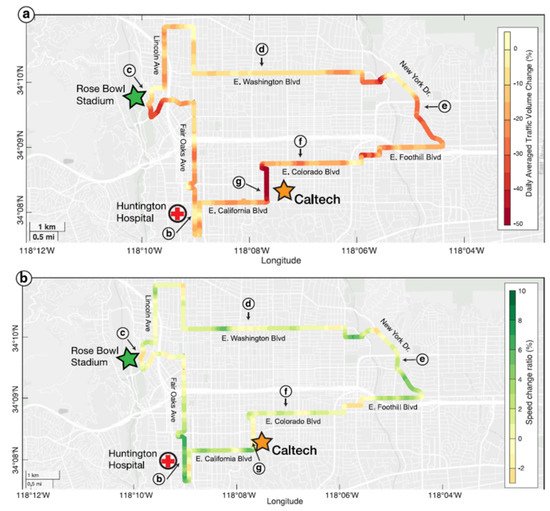

Figure 57. (a) A map showing the changes in average daily traffic volume before and after lockdown using DAS-based transportation analysis; (b) a map showing the degree of change in mean traffic speed before and after lockdown using DAS-based transportation analysis [54][63].
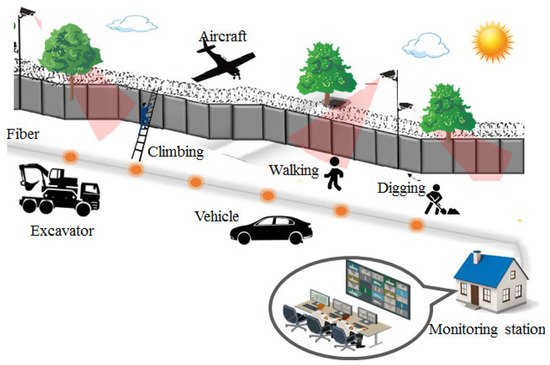
Although DAS has great application potential in highway traffic monitoring, it also faces many challenges. For instance, the deformation coupling of fiber-optic cables in some highway sections is limited and it is impossible to accurately record the vibration signals generated by traveling vehicles as during heavy traffic congestion periods, it is difficult to accurately distinguish the vibration signals generated by each type of vehicle, which would adversely affect the traffic flow statistics.
6. Pipeline Safety Monitoring
As safe and cheap transportation devices, pipelines are widely used for the transportation of oil, natural gas, and other products. The real-time monitoring of pipeline operation status can effectively maintain pipeline safety and prolong pipeline service life. DFOS is a technology that developed rapidly in the 1980s. It has been widely used in pipeline safety monitoring in recent years. For instance, distributed temperature sensing (DTS) technology is used to monitor pipeline leakages [60][61][69,70] and distributed strain sensing (DSS) technology is used to monitor pipeline deformations [62][63][64][71,72,73]. However, they are static monitoring technologies and cannot perform the real-time and dynamic monitoring of pipelines. The vigorous development of DAS has provided new ideas and solutions for the dynamic monitoring of pipelines.
7. Tunnel Structure Health Monitoring
As essential public transportation facilities, tunnels can greatly shorten driving distances, save transportation costs, and protect ecological environments. However, in the process of tunnel construction, geological disasters, such as water leakages and floods, often occur [65][92]. These incidents pose a serious threat to the health of tunnels. Therefore, there is an urgent need for real-time and comprehensive evaluation technologies to monitor tunnel health status.
DAS provides a brand new tool for tunnel health monitoring [66][67][68][93,94,95]. Based on a scattering-enhanced fiber-optic DAS system, Hu et al. performed the intelligent monitoring of a tunnel ring [67][94]. They laid cables on a steel ring structure to monitor vibration frequency. Using the monitoring data, they assessed and classified the health status of the steel ring based on machine learning algorithms. The recognition accuracy of the final test was as high as 97.8%, indicating that DAS can be used to monitor the health condition of tunnel structures.
Aiming to mitigate potential disaster events during tunnel construction, Zhang et al. proposed a DAS-based disturbance event identification method [68][95]. They laid cables along a tunnel lining and used a random forest algorithm to analyze the DAS data. They successfully identified various vibration events during tunnel construction, including unexpected disasters, such as rockfalls. Its recognition accuracy rate is as high as 92.31%.
8. Border Security Monitoring
In this era of cross-border terrorism and illegal immigration, many countries around the world are actively seeking ways to effectively protect their borders. Traditional border security technologies (radars, electro-optical/infrared, fencing, etc.) have shortcomings, such as being susceptible to electromagnetic and terrain interference and requiring the frequent maintenance of detection devices. DAS offers a new approach to border security. It can perform long-distance detection, classification, and localization, which enables timely responses to various border intrusion events (as shown in Figure 69). In addition, DAS provides low-noise and high-spatial resolution acoustic and seismic sensing that can detect and identify personnel, vehicle, and even aircraft intrusions. Therefore, DAS-based border security technology is regarded as a future development direction in the border security field.

Duckworth et al. investigated DAS responses to different intrusion events and found that DAS can not only capture the vibration signals of personnel footsteps but also respond well to intrusion events that are difficult to detect using conventional security technologies, such as digging, gunshots, underground excavation, and aircraft intrusion [70][96]. This fully demonstrates the application potential of DAS in border intrusion monitoring. However, there are some challenges; for instance, how to quickly discover and locate intrusion events within huge amounts of monitoring data and how to eliminate the interference of non-human invasion events (such as animal activities). To solve the above challenges, on the one hand, artificial intelligence technology (machine learning, deep learning, etc.) could be used to improve the efficiency of data processing or on the other hand, comprehensive analysis platforms for multivariate data (DAS data, radar data, video surveillance data, etc.) could be developed to analyze multivariate information and make comprehensive decisions in order to reduce the false positive and false negative rates of intrusion events.
10. Other Applications
In addition to the applications listed above, there are some other cases that use DAS to monitor linear infrastructures. For instance, cables buried in airport runways can be used for aircraft monitoring [71][98]. A pioneering work was carried out by the scientific research team of Beijing Jiaotong University. They presented an aircraft acoustic signal detection system based on DAS and analyzed the seismic waves excited by aircrafts. The 5 Hz region was shown to be the most meaningful frequency range. Researchers have also focused on the health monitoring of wind turbine towers and proposed methods to detect the structural phenomena associated with loose bolts and material damage within the towers [72][99]. Based on the amplitude, frequency, power spectrum, and other characteristics of the data, loose bolts and material damage within towers can be monitored, which is of great significance for the maintenance of wind towers.
